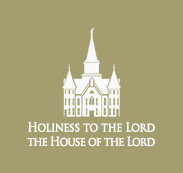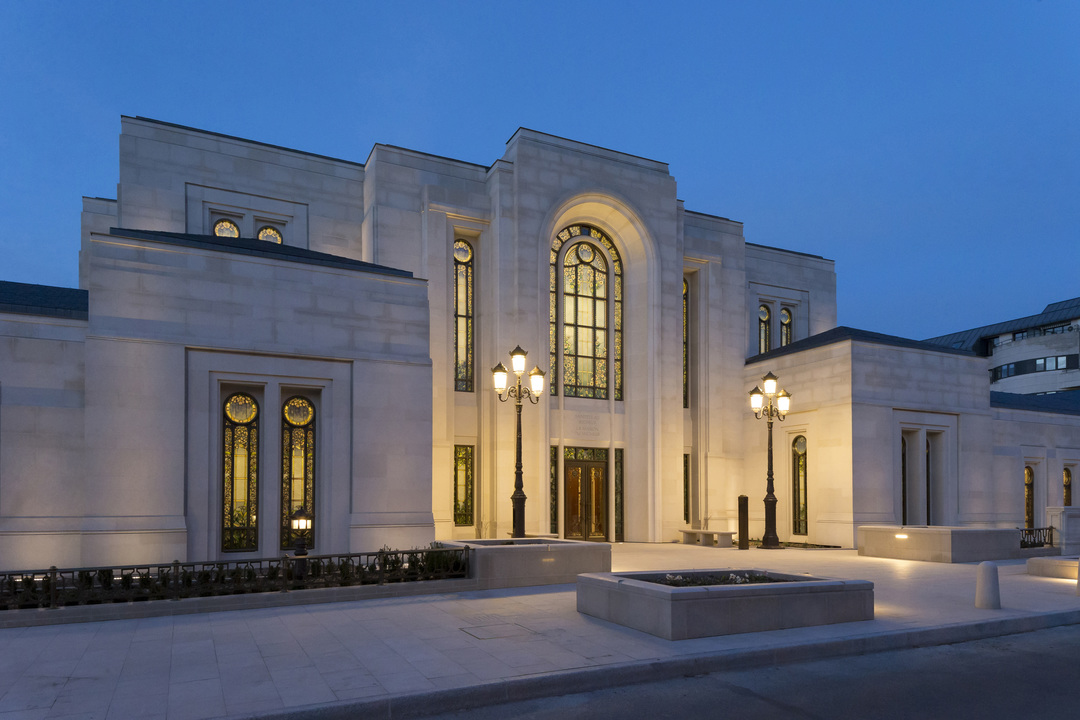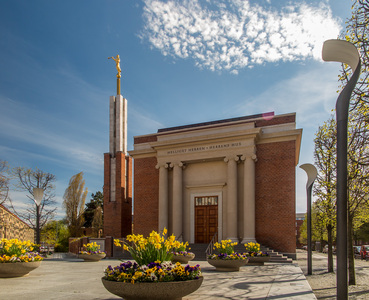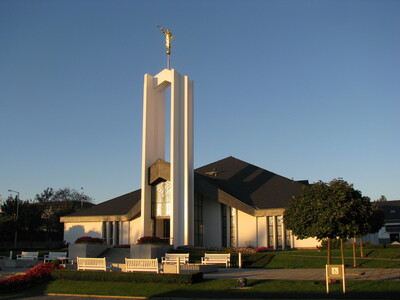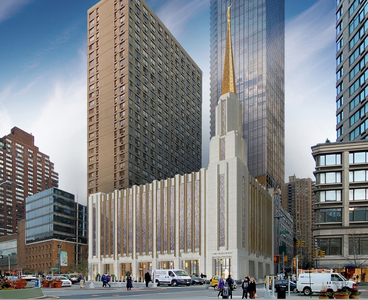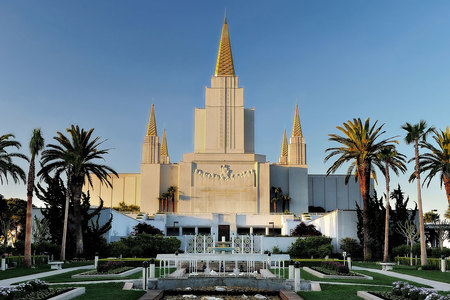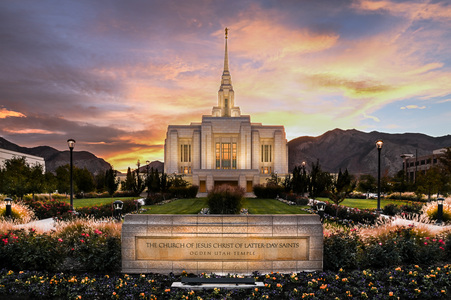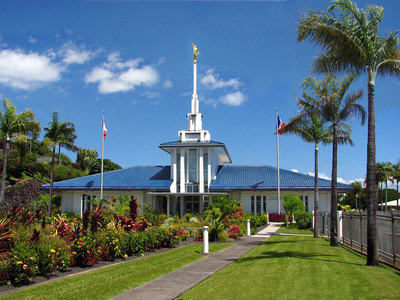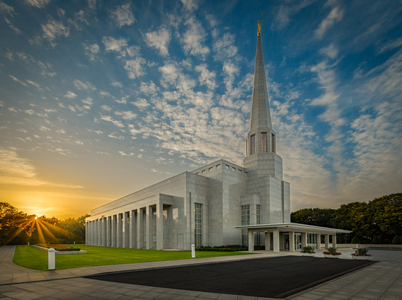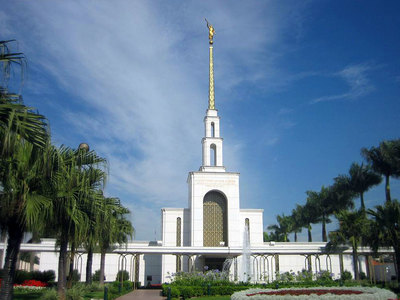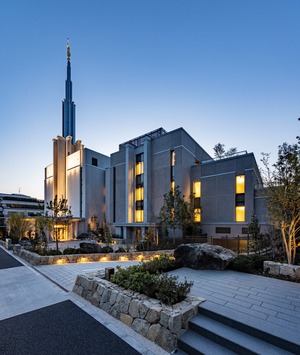Services
Visitors' center open to the publicArrival center available
Patron housing available
Distribution center on site (Store Locator)
Announcement:
1 October 2011Construction Commencement:
24 August 2012Public Open House:
22 April–13 May 2017Dedication:
21 May 2017 by Henry B. EyringSite:
2.26 acres | 0.9 hectaresExterior Finish:
Warm-toned limestone with character reflective of limestone used in the Le Chesnay and Versailles regionsArchitectural Features:
Flat roof with a central skylightOrdinance Rooms:
Two instruction rooms (two-stage progressive), three sealing rooms, and one baptistryTotal Floor Area:
44,175 square feet | 4,104 square metersElevation:
390 feet | 119 metersTemple Locale
The Paris France Temple graces the streets of Le Chesnay in the western suburbs of Paris, just a stone's throw away from the vast grounds of the Palace of Versailles where French royalty once resided. A marble reproduction of Thorvaldsen's Christus statue is a focal point of the beautifully landscaped grounds, accented by water features on the north and south ends of the property. Guests are welcomed at a visitors' center that features a three-dimensional cut-away model of the temple. Also on site are a residence for the temple president and matron, housing facilities for patrons and temple missionaries, and an underground parking facility.
Temple Facts
The Paris France Temple was the twelfth temple built on the continent of Europe and the first built in European France. The first temple built in the French Republic was the Papeete Tahiti Temple (1983).
The Paris France Temple was the first temple designed without an angel Moroni statue since the Oakland California Temple (1964), excluding these temples that had angel Moroni statues added years after their dedications: the Ogden Utah Temple (1972), the Provo Utah Temple (1972), the São Paulo Brazil Temple (1978), the Tokyo Japan Temple (1980), and the Freiberg Germany Temple (1985).
The Paris France Temple was constructed on the site of two buildings that had been leased by a state-owned electric utility company. The buildings were razed in August 2013 following an extensive asbestos removal process.
A traditional groundbreaking ceremony was not held for the Paris France Temple.
Temple History
Announcement
The official announcement of the Paris France Temple was issued as a news release from Church headquarters on July 15, 2011, because French newspapers were already circulating reports of the temple plans, which had been submitted to the local government for approval. The temple announcement was reaffirmed by President Thomas S. Monson in the following General Conference on October 1, 2011. After announcing several new temples, he stated: "In addition, we're moving forward on our plans for a temple to be built in Paris, France."
Government Approval
While seeking approval for construction of the Paris France Temple, Bishop Gérald Caussé met with the mayor of Le Chesnay to give a presentation. The mayor did not want a presentation, however. Instead, he informed Bishop Caussé that he and his team would investigate the character of the Church themselves. At a follow-up meeting, a City Councilor on the team, who was also a professor of religious history, explained that they had attended a sacrament meeting and talked to neighbors about their impressions of the Latter-day Saints. Through their research, they concluded that The Church of Jesus Christ of Latter-day Saints was the closest to Jesus Christ's original church that they knew of.
Construction
On June 13, 2014, Elder Neil L. Andersen of the Quorum of the Twelve Apostles came to the temple site during construction. He met with approximately 60 people involved with the project including architects, lawyers, builders, contractors, and construction company representatives. "I explained to them that this will be a house of the Lord," said Elder Andersen. He also spoke to them of angels saying: "They minister to people on this earth. This sacred temple will be one place where angels will be. We want you to build a building that you know will be a holy building." One of the lawyers said, "I have not been a religious man, but I feel there is something very special about this temple."1
Open House
During the three-week open house held for the Paris France Temple, a total of 47,561 guests toured the beautiful structure and its visitors' center.
Cultural Celebration
"Que la fête commence (let the party begin)," said President Henry B. Eyring on May 20, 2017, to the 950 youth gathered at the Velodrome National de Saint-Quentin-en-Yvelines for the youth cultural celebration, marking the completion of the Paris France Temple. The performance celebrated the Reformation, the Restoration, and the dedication of the temple in a colorful and musical display that honored the tradition of faith in France.2
Dedication
On May 21, 2017, President Henry B. Eyring, first counselor in the First Presidency, dedicated the Paris France Temple. He said on that occasion: "We rejoice with the Saints of France and surrounding countries that today a holy house of God is dedicated in your midst—adding an eternal dimension to the beauty of this great and historic part of the Lord’s kingdom."3 In his dedicatory prayer, he blessed the country saying, "We are grateful for the hospitality of this historic city in this great nation and pray that it may be blessed by the very presence of Thy house. May the light of the gospel that emanates from this holy temple be felt throughout the land."
Temple Background
On August 1, 1976, President Spencer W. Kimball spoke to the French Saints at a member meeting held in Paris where he said: if "we clenched our fists and gritted our teeth, a temple will be available to the members here." He also promised that in the process, Church membership in the country would "double, even quadruple." At the time, Church membership stood at approximately 10,000 members in France. Four decades later, when Paris France Temple was dedicated, membership had grown to nearly 40,000—a fulfillment of the words spoken by a loving and determined prophet.4
On June 4, 1998, during a European tour to dedicate the Preston England Temple, President Gordon B. Hinckley met with about 2,400 members from two Paris stakes and three outlying districts. In his remarks, he noted, "When I came here after the war, there were so few members of the Church, and now there are 30,000 of you." He continued, "I don't want to build up your hopes, but the time has come when you deserve to have a temple among you, and we'll look for a place to build one. I don't know how long it will take to find a suitable site. I invite every one of you, my brethren and sisters, to plead with the Lord individually in your prayers to lead us to a property in this great city, or its environs, where we can build a house of the Lord so that you won't have to travel five hours to Frankfurt or six hours to Zollikofen. Please unite your prayers with ours, and the time will come, and I hope that it will be quick in coming, when we can construct somewhere in this area a house of the Lord, a sacred temple, into which you can go and do that work which is found only in the temples of the Lord."5
In May 2004, President Hinckley returned to Paris, shortly after the dedication of the Copenhagen Denmark Temple. He met with French members on May 28 in a hotel convention hall on the property of Euro Disney. Remarking on the upcoming dedication of the Manhattan New York Temple, President Hinckley expressed, "I wish I could announce that we could have a temple here, but we do not have a suitable place yet, in my judgment, to build it. And so, we will continue to look. I don't know when it will be built, but I am confident that we will have a temple for the French-speaking people of the Church sometime in the future." Continuing he said, "You are worthy of the richest blessings of the Church. You are worthy of every blessing which this Church has to offer. And there is no blessing greater than the blessing of the house of the Lord. And so, my brothers and sisters, I ask you to be patient for a time. I know it is a long way to Frankfurt where you go. I hope that you will continue to go there, but sometime in the future a beautiful house of the Lord will grace this land."6
As the April 2006 General Conference approached, hopes rose that the Paris France Temple would be announced when French media disclosed the Church's interest in purchasing a huge tract of land outside Versailles—about one-third of the small city of Villepreux. A church spokesman confirmed the Church was working with the property owners, but he said that the use of the property had not been determined and that temple locations were announced by the First Presidency. The summer before, President Hinckley had been considering a parcel of land in Saint-Cloud, a suburb of Paris, but attention had now turned to the Villepreux property. The Clerico family, owners of the Moulin Rouge, were the owners of this property as well. Of the three interested parties—an Arab emirate, a Russian, and the Latter-day Saints—the mayor of Villepreux said he preferred the Latter-day Saints for two reasons: morality and quality of investment. He said: Never has there been any concern about public order with church members.7 No temple announcement was made, however, and in the end, the Church did not succeed in acquiring the property.
Temple Approval
On June 21, 2010, the French newspaper Le Parisien reported that Church officials were seeking to acquire property in Le Chesnay, in the western suburbs of Paris, for construction of its first temple in mainland France. The buildings that occupied the site were leased by Électricité de France (EDF), but representatives of the company confirmed that they would not be renewing their lease after it expired in October 2010. Since rezoning would not be necessary, construction approval would require only the signature of Mayor Philippe Brillault. "Do we favor the Mormons [for this location]?" the mayor posed in a public statement. "The answer is no. But we're not against their architectural plans, and the City cannot oppose a request that conforms to the City Plan." Gerald Caussé, First Counselor in the Europe Area Presidency, emphasized that the process was in the preliminary stages only and that nothing had been decided.8
On October 11, 2010, Le Parisien confirmed that the Church had applied to purchase the buildings leased by EDF. However, the article reported that two other interested parties had come forward including the Academy of Versailles and a residential developer. In the end, the owner would be the sole decision maker. Mayor Brillault said the only certainty was that EDF would leave, but it was not known when that would occur. Next, the question was whether to sell or rent, which came with many options and unknowns.9
On July 12, 2011, Le Parisien reported that detailed plans for the temple complex had been submitted to the City for approval. In turn, Mayor Philippe Brillault invited residents of the surrounding neighborhood to a Saturday morning informational meeting. Mayor Brillault explained that the temple emerged early as the strongest and most profitable project put forward by interested parties. He said that, according to his understanding, a temple and housing facility would be constructed with an underground parking facility; he also touted the beautiful gardens that would be open for public enjoyment. The vast majority of opposition, if not all, to the project resulted from an erroneous perception of The Church of Jesus Christ of Latter-day Saints as a cult. One Church member stated, "We are victims of misunderstanding and confusion. We are normal people."10
On August 26, 2011, Le Parisien informed readers that the Church had successfully acquired the land on Boulevard Saint-Antoine, formerly leased by EDF, to build its temple, housing facility, and landscaped gardens. Mayor Brillault indicated that following an informational meeting for neighbors in July, the architects agreed to some changes to the design, which pleased them. City planners then had two months to verify that the permit complied with the City Plan.11
On November 9, 2011, Le Parisien announced that the building permit for the Paris France Temple had been issued by the City on October 27, 2011, calling it a "done deal" and making the community of Le Chesnay the site of the first temple of The Church of Jesus Christ of Latter-day Saints built in mainland France. A member of the City Council noted that because the project complied with the City Plan, there were no grounds to oppose it.12 However, just before the end of the year, four appeals to the approval were received by the mayor from opponents of the project who launched an online petition, arguing the land should be used for low-income housing. The mayor's office had two months to respond.13
On February 8, 2012, Le Parisien delivered the news that all four appeals had been rejected. The mayor explained that none of the arguments were likely to call into question the decision to grant the building permit. One applicant said his resolve was only strengthened and that he would take his appeal to court, which had to be submitted within two months. Church spokesman, Christian Euvrard, said that Church members watched the proceedings closely, sometimes with disappointment as they are often the victims of stereotypes.14
On March 17 and 18, 2012, Church members offered an open house at the Versailles meetinghouse to give neighbors of the temple an opportunity to receive additional information about the temple and to familiarize themselves with the The Church of Jesus Christ of Latter-day Saints, as a general misunderstanding of the Church existed among French citizens. At the open house, one Church member expressed his understanding for the fear neighbors may feel toward the Church because of the stereotypes that exist, which label the Church as a cult and a culture that lives on the fringes of modern society. "We are quite normal," he explained, noting that Church members simply choose to live certain moral principles such as no alcohol or tobacco, weekly church attendance, and tithing. The open house was organized in response to opposition to the project from the individuals who had challenged acceptance of the building permit.15 Christian Euvrard, director of the Paris France Institute, gave a 13-minute television interview in conjunction with the open house.
By April 2012, two administrative appeals had been filed with the objective of cancelling the building permit. The appeals were examined by lawyers for the Church and came as no surprise to Church officials who remained confident in a favorable outcome. The appeals posed no legal barrier to the commencement of construction.16 As such, construction on the temple started later that year. By the fall of 2014, the administrative appeals had been denied by the court system, removing all legal obstacles from the temple moving forward.17
- Gerry Avant, "Elder Andersen Visits Construction Site of Paris France Temple," Church News 19 Jun. 2014.
- Sarah Jane Weaver, "French LDS Youth Honor Light of Faith during Cultural Celebration," Church News, 20 May 2017.
- Sarah Jane Weaver, "Paris France Temple dedication: A tribute to the faith, sacrifice of pioneer members," Church News, 21 May 2017.
- Sarah Jane Weaver, "President Eyring Dedicates Paris France Temple," Church News 21 May 2017.
- "President Hinckley Meets Members in Maine and Europe," Ensign Sept. 1998: 75–78.
- "'You are worthy of the richest blessings,'" Church News 5 Jun. 2004.
- Carole Mikita, "LDS French Hoping for Temple Announcement," KSL.com 30 Mar. 2006.
- Marie D'Ornellas, "Les mormons veulent construire leur temple," Le Parisien 21 Jun. 2010.
- "Les mormons intéressés par le bâtiment EDF," Le Parisien 11 Oct. 2010.
- Francois-Xavier Chauvet, "Un temple mormon à la place d'EDF," Le Parisien 12 Jul. 2011.
- Marie D'Ornellas, "Les mormons ont déposé leur permis de construire," Le Parisien 26 Aug. 2011.
- Françios-Xavier Chauvet, "Le maire a dit oui au temple des mormons," Le Parisien 9 Nov. 2011.
- "Quatre recours contre le projet de temple mormon," Le Parisien 28 Dec. 2011.
- Francois-Xavier Chauvet, "Les recours contre les mormons rejetés," Le Parisien 8 Feb. 2012.
- Francois-Xavier Chauvet, "Yvelines : les Mormons lancent une opération séduction," Le Parisien 17 Mar. 2012.
- Francois-Xavier Chauvet, "Les mormons n'abdiquent pas," Le Parisien 8 May 2012.
- "Temple mormon du Chesnay : plus rien ne pourra l’arrêter," Toutes Les Nouvelles 30 Sep. 2014.
